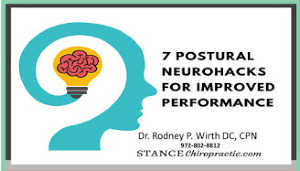Where’s Your Head?
Discover the reasons STANCE Chiropractic provides posture rehabilitation through coordinated eye movements in order to improve your head forward posture.
The Role of Eyes in Posture
Having proper head posture depends on the visual and vestibular systems to keep your eyes parallel to the horizon and to make you aware if you are holding your head upright. The visual and vestibular systems feed straight into the brain stem which is also called “powerhouse” of postural control. There are cranial nerves that send electrical signals from the brain to let your head know where it is in space.
Posture Rehabilitation
Your eyes are super important for proper posture. They orient you to your environment at all times. The proper coordination of eye movements will prevent chronic postural distortion patterns.
Brain to Spine
When impulses reach the visual cortex, your brain interprets them and uses them to determine how the body should respond. The brain sends messages down the spinal cord to tell the rest of your body how to react to what the eyes see.
When you have good posture, the communication between the brain and the spine is uninterrupted and quick. Your neurons stay in constant command of your body, using information gathered from each of the five senses, including sight.
Eyes to Spine
When your posture become hunched or slumped the connection quality between the spinal cord deteriorates. The results can be a lag between the time This creates a lag between your eyes seeing an object, your brain interpreting the image of the object, and your body responding to the object. In fact, poor posture can result in many health issues, including slowed circulation, shallow breathing, and blurred vision.
But the relationship also goes the other way. If you have poor eyesight, you may squint, lean forward, or tilt your head into an unnatural position to see more clearly. These movements create muscle tightness in the shoulders, neck, and head. Over time, this maladjustment can decrease blood flow to and from your eyes.
Results of This Connection
When you have healthy posture and decent (or corrected) eyesight, the connection between your spine and your eyes remains strong. The cranial nerves communicate freely and the function of your involuntary posture system thrives. Let’s talk a little more about your cranial nerves.
Posture Related Cranial Nerves
A key part of your nervous system consists of the cranial nerves. They are a set of 12 paired nerves in the back of your brain. These nerves send electrical signals between the brain and different parts of your face, neck and torso. These are the signals that help you be able to smell, taste, move your eyes and hear.
In the posture rehabilitation we focus on exercises for cranial nerves III, IV, VI and VIII.
Cranial nerve III is called the Oculomotor nerve that controls the ability to move and blink your eyes.
Cranial nerve IV is called the Trochlear nerve that controls the ability to move your eyes up and down and back and forth.
Cranial nerve VI is called the abducens nerve and lets you move your eyes.
Cranial nerve VIII is called the vestibular nerve and deals with your balance.
Tips to Correcting Posture Problems
- Take frequent posture breaks
- Cross your eyes by putting your finger in front of your nose
- Stretch your neck from side to side








